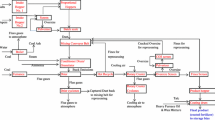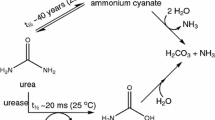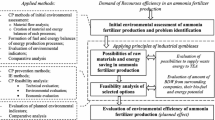Abstract
In this study, an ammonia flow analysis that presents how ammonia is used or handled in the South Korean fertilizer industry is developed using material flow analysis concepts. Due to increasing concerns related to ammonia-related accident cases and human health and toxicity impacts in the country, an ammonia flow analysis is presented in this study. Ammonia data were collected from several data sources, such as the National Statistical Office of South Korea and the 2019 edition of the fertilizer yearbook, published by the Korean Fertilizer Association. The results show that 1,840,000 tons of ammonia were used or handled in domestic manufacturing. Furthermore, the total amount of ammonia used in the fertilizer industry, including 504,000 tons in the manufacture of fertilizers and nitrogen compounds, amounts to 757,000 tons. The amount of ammonia in the import and production of fertilizer and the past stock is inversely estimated utilizing the process of manufacture and LCI data. The amounts have been concluded to be 565,000 (508,000–621,000) tons of urea, 1420 (1279–1563) tons of ammonium sulfate/ammonium nitrate, and 981,000 tons of composite fertilizer, which were found to be used or handled in the export, agriculture, industry, stock, and raw materials. The developed ammonia flow analysis contributes to increased safety measures in industries that utilize significant amounts of ammonia and other chemicals responsible for industrial injuries and deaths, such as carbon monoxide, chlorine, hydrochloric acid, and sulfuric acid. Furthermore, due to ammonia’s high toxicity levels towards animals and plants and damages to human respiratory systems, the presented analysis can be a critical part of minimizing these impacts. And finally, while the geographic scope is limited to South Korea, the study is applicable to and replicable in other regional scopes, especially those that experience significant human health impacts related to ammonia.
Graphical abstract



Similar content being viewed by others
References
EC 1907/2006, https://ec.europa.eu/environment/chemicals/reach/reach_en.htm; https://eur-lex.europa.eu/legal-content/EN/TXT/?uri=CELEX:32006R1907. Assessed May 2020
K-REACH. http://kreach.cirs-group.com; http://kreach.cirs-group.com/en/k-reach/background, K-REACH, Enforcement Date 01. Jan, 2019, Act No.15844, 2020
Korea Chemicals Control Act (CCA), https://www.kcma.or.kr/eng/sub4/4_1.asp. Assessed May 2020
FAO (Food and Agriculture Organization of the United Nations) (1991) Manual on fertilizer statistics. FAO, New York
DOH NYS (Department of Health, New York State) https://www.health.ny.gov/environmental/emergency/chemical_terrorism/ammonia_tech.htm. Assessed Feb 2021
CSCH (Chemistry Saftey Cleaning-house). http://csc.me.go.kr. Assessed May 2020
MOE (Ministry of Environment), “3rd Hazardous Chemicals Management Plan (2011~2015)”, 30, 2010
Brunner PH et al (1997) Materials Accounting as a Tool for Decision Making in Environmental Policy (MAcTEmPo). 1st Progress Report, April 1997. TU Vienna, Linköping University, ETH Zürich and Leiden University
Udo de Haes HA, van der Voet E, Kleijn R (1997) Substance Flow Analysis (SFA), an analytical tool for integrated chain management. In: Bringezu S et al (eds) Regional and national material flow accounting: from paradigm to practice of sustainability. Proceedings of the ConAccount workshop 21–23 January 1997, Leiden
Pivnenko K, Laner D, Astrup TF (2016) Material cycles and chemicals: dynamic material flow analysis of contaminants in paper recycling. Environ Sci Technol 50(22):12302–12311
Fischer-Kowalski M (1998) Society’s metabolism: the intellectual history of materials flow analysis, part I, 1860–1970. J Ind Ecol 2(1):61–78
Qiao M, Zheng YM, Zhu YG (2011) Material flow analysis of phosphorus through food consumption in two megacities in northern China. Chemosphere 84(6):773–778. https://doi.org/10.1016/j.chemosphere.2011.01.050
Wang S, Dai J, Su M (2012) Material flow analysis of fossil fuels in China during 200–210. Sci World J 2012:8 (Article ID 625828)
Fishman T, Schandl H, Tanikawa H, Walker P, Krausmann F (2014) Accounting for the material stock of nations. J Ind Ecol 18(3):407–420. https://doi.org/10.1111/jiec.12114
Smit AL, van Middelkoop JC, van Dijk W et al (2015) A substance flow analysis of phosphorus in the food production, processing and consumption system of the Netherlands. Nutr Cycl Agroecosyst 103:1–13. https://doi.org/10.1007/s10705-015-9709-2
Yoshida H, Christensen TH, Guildal T, Scheutz C (2015) A comprehensive substance flow analysis of a municipal wastewater and sludge treatment plant. Chemosphere 138:874–882. https://doi.org/10.1016/j.chemosphere.2013.09.045
Ju M, Osako M, Harashina S (2016) Quantitative analysis of food products allocation into food consumption styles for material flow analysis of food. J Mater Cycles Waste Manag 18:589–597. https://doi.org/10.1007/s10163-015-0358-y
Pham HG, Harada H, Fujii S et al (2017) Transition of human and livestock waste management in rural Hanoi: a material flow analysis of nitrogen and phosphorus during 1980–2010. J Mater Cycles Waste Manag 19:827–839. https://doi.org/10.1007/s10163-016-0484-1
Li X, Lin J, Zhang D, Xiong Z, He X, Yuan M, Wang M (2020) Material flow analysis of titanium dioxide and sustainable policy suggestion in China. Resour Policy 67:101685
Kim J, Hwang Y, Yoo M, Chen S, Lee I-M (2017) Hydrogen fluoride (HF) substance flow analysis for safe and sustainable chemical industry. Environ Sci Pollut Res 24(32):25137e25145. https://doi.org/10.1007/s11356-017-0152-6
Lee SJ, Kim JW, Hwang YW, Kim JB, Kim YW, Chen S (2019) Butadiene substance flow analysis and management in South Korea. J Clean Prod 220:331–339
van Gils J, Posthuma L, Cousins IT, Brack W, Altenburger R, Baveco H, Focks A, Greskowiak J, Kühne R, Kutsarova S, Lindim C, Markus A, van de Meent D, Munthe J, Schueder R, Schüürmann G, Slobodnik J, de Zwart D, van Wezel A (2020) Computational material flow analysis for thousands of chemicals of emerging concern in European waters. J Hazard Mater 397:122655. https://doi.org/10.1016/j.jhazmat.2020.122655
Korea Fertilizer Industry Association, Fertilizer yearbook (2015)
Jung SC, Park JA, Huh JH, So KH (2011) Estimation of greenhouse gas emissions of complex fertilizers production system by using life cycle assessment. Korean Soc Soil Sci Fertilizer 44(2):256–262
Korea Customs Service, Import and Export Trade Statistics. http://www.customs.go.kr/. Assessed June 2020
KOSHA (Korea Occupational Safety & Health Agency) (2018) Workplace Conditions Survey Report
Gsodama P, Lassniga M, Kreuzederb A, Mrotzek M (2014) The Austrian silver cycle: a material flow analysis. J Resour Conserv Recycl 88:76–84
Brunner PH, Rechberger H (2016) Handbook of material flow analysis: for environmental, resource, and waste engineers, 2nd edn. CRC Press, New York (ISBN: 9781498721349 - CAT# K25579)
Kim CH, Geum MG (2015) Improvement and Issue regulations of domestic ammonia refrigerant. Mag Soc Air-condition Refrigerating Eng Korea 44(7):58–59
NIER (National Institute of Environmental Research), Pollutant Release and Transfer Registers. http://ncis.nier.go.kr/prtr/index.do. Assessed Aug 2020
Ostad-Ali-Askari K, Shayannejad M (2021) Quantity and quality modelling of groundwater to manage water resources in Isfahan-Borkhar Aquifer. Environ Dev Sustain. https://doi.org/10.1007/s10668-021-01323-1
Golian M et al (2020) Prediction of tunnelling impact on flow rates of adjacent extraction water wells. Quart J Eng Geol Hydrogeol. 53(2):236. https://doi.org/10.1144/qjegh2019-055
Ostad-Ali-Askari K et al (2017) Artificial neural network for modeling nitrate pollution of groundwater in marginal area of Zayandeh-Rood River, Isfahan, Iran. KSCE J Civ Eng Korean Soc Civ Eng. 21(1):134–140. https://doi.org/10.1007/s12205-016-0572-8
Kawecki D, Wu Q, Gonçalves JSV, Nowack B (2021) Polymer-specific dynamic probabilistic material flow analysis of seven polymers in Europe from 1950 to 2016. Resour Conserv Recycl 173:105733
Wang C, Liu Y, Chen W-Q, Zhu B, Qu S, Xu M (2021) Critical review of global plastics stock and flow data. J Ind Ecol 13:1300–1317
Thushari I, Vicheanteab J, Janjaroen D (2020) Material flow analysis and life cycle assessment of solid waste management in urban green areas, Thailand. Sustain Environ Res 30:21. https://doi.org/10.1186/s42834-020-00057-5
Velásquez-Rodríguez F, Løvik AN, Moreno-Mantilla CE (2021) Evaluation of the environmental impact of end-of-life refrigerators in Colombia by material flow analysis. J Clean Prod 314:127884
Kullmann F, Markewitz P, Stolten D et al (2021) Combining the worlds of energy systems and material flow analysis: a review. Energy Sustain Soc 11:13
Knapp W (2001) Tolerance and uncertainty. WIT Trans Eng Sci. https://doi.org/10.2495/LAMDAMAP010321
Acknowledgements
This work was supported by 1) an Inha University Research Grant and, 2) the Korea Institute for Advanced of Technology (KIAT) grant funded by the Korea Government (MOTIE) (P0008421, The Competency Development Program for Industry Specialist).
Author information
Authors and Affiliations
Corresponding author
Additional information
Publisher's Note
Springer Nature remains neutral with regard to jurisdictional claims in published maps and institutional affiliations.
Rights and permissions
About this article
Cite this article
Kim, J., Lee, SJ., Lee, GH. et al. Ammonia flow analysis in the domestic fertilizer industry of South Korea. J Mater Cycles Waste Manag 24, 517–527 (2022). https://doi.org/10.1007/s10163-021-01338-w
Received:
Accepted:
Published:
Issue Date:
DOI: https://doi.org/10.1007/s10163-021-01338-w




